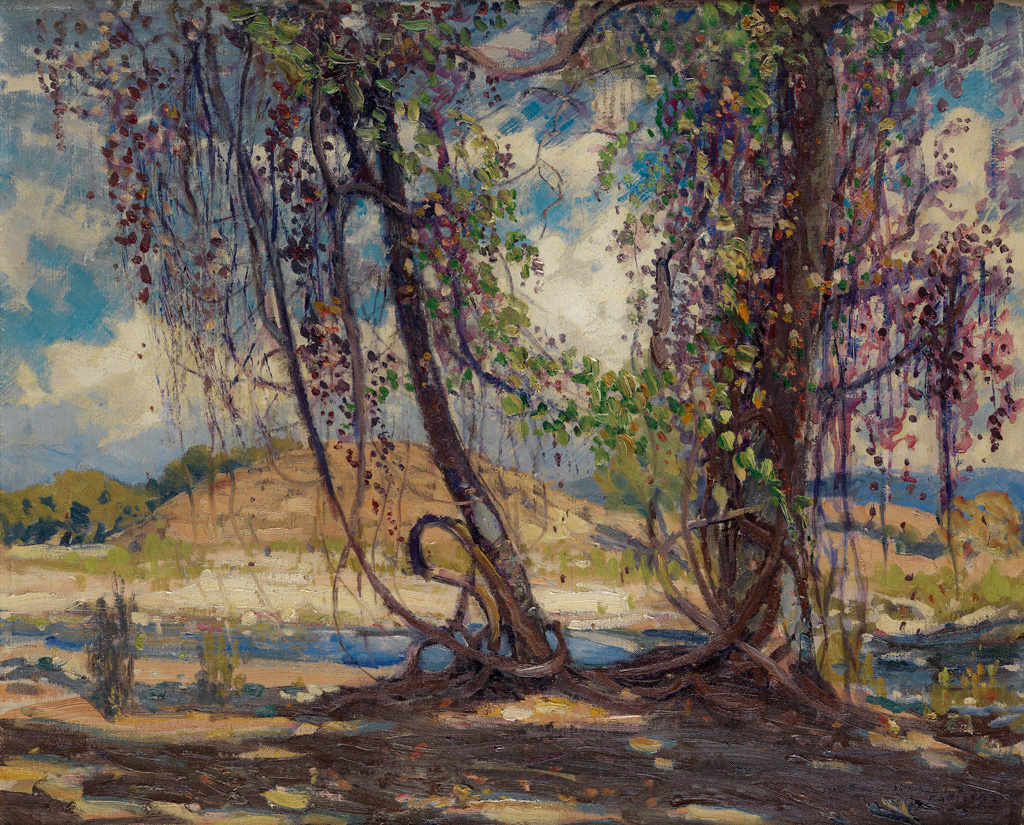Sale 2452 - Lot 37
Unsold
Estimate: $ 100,000 - $ 150,000
JOSEPH KLEITSCH
San Juan Capistrano.
Oil on canvas, 1923. 560x680 mm; 22x26 3/4 inches. Signed, titled "Capistrano" and dated in oil, lower right recto. In the original hand carved frame.
Acquired directly from the artist by the current owner's family; private collection, Texas.
Kleitsch (1882-1931) was born in the Banat region of Hungary and began painting at an early age. As a teenager he left his small village to study art in Budapest, and continued his training in Munich and Paris before immigrating to the United States in his late teens, settling in Cincinnati in 1901. Thereafter he spent time in Denver, Mexico City and Chicago, where he gained prominence as a preeminent portrait painter (he was the official portraitist to Mexican President Francisco Madero for several years). After taking classes and teaching at the Art Institute of Chicago, Kleitsch moved to Laguna Beach, California in 1920, then the center of a burgeoning artist community.
Laguna Beach was an epicenter of California Impressionism--a regional school of American Impressionism of en plein air painting, mostly practiced by ex-patriate Europe artists, living and working in the San Francisco Bay Area and Southern California. The unspoiled, undeveloped coastline of Laguna Beach attracted many of these artists, who started a number of different local artist organizations, including the Laguna Beach Art Association (Kleitsch even opened his own school with his wife, the Kleitsch Academy). Although he continued to paint portraits (he was an in-house portraitist for the esteemed Stendahl Gallery, Los Angeles), it was in Laguna where Kleitsch discovered his passion for landscape painting.
Kleitsch was deeply inspired by the light of the Laguna coast, and he used rich, jewel-toned colors to depict its play on the unique landscape. He continued to paint masterful still lifes and portraits in addition to landscapes and seascapes, and also made an effort to paint Laguna itself (then still a relatively small and undeveloped town) to record its environs before development inevitably altered it forever. A unique character, Kleitsch played the accordion and could sometimes be found playing for passersby for hours at a time. This joie de vivre is clearly evidenced in his attitude towards painting as well, with his vigorous, energetic brushstrokes and vividly bold colors.
San Juan Capistrano.
Oil on canvas, 1923. 560x680 mm; 22x26 3/4 inches. Signed, titled "Capistrano" and dated in oil, lower right recto. In the original hand carved frame.
Acquired directly from the artist by the current owner's family; private collection, Texas.
Kleitsch (1882-1931) was born in the Banat region of Hungary and began painting at an early age. As a teenager he left his small village to study art in Budapest, and continued his training in Munich and Paris before immigrating to the United States in his late teens, settling in Cincinnati in 1901. Thereafter he spent time in Denver, Mexico City and Chicago, where he gained prominence as a preeminent portrait painter (he was the official portraitist to Mexican President Francisco Madero for several years). After taking classes and teaching at the Art Institute of Chicago, Kleitsch moved to Laguna Beach, California in 1920, then the center of a burgeoning artist community.
Laguna Beach was an epicenter of California Impressionism--a regional school of American Impressionism of en plein air painting, mostly practiced by ex-patriate Europe artists, living and working in the San Francisco Bay Area and Southern California. The unspoiled, undeveloped coastline of Laguna Beach attracted many of these artists, who started a number of different local artist organizations, including the Laguna Beach Art Association (Kleitsch even opened his own school with his wife, the Kleitsch Academy). Although he continued to paint portraits (he was an in-house portraitist for the esteemed Stendahl Gallery, Los Angeles), it was in Laguna where Kleitsch discovered his passion for landscape painting.
Kleitsch was deeply inspired by the light of the Laguna coast, and he used rich, jewel-toned colors to depict its play on the unique landscape. He continued to paint masterful still lifes and portraits in addition to landscapes and seascapes, and also made an effort to paint Laguna itself (then still a relatively small and undeveloped town) to record its environs before development inevitably altered it forever. A unique character, Kleitsch played the accordion and could sometimes be found playing for passersby for hours at a time. This joie de vivre is clearly evidenced in his attitude towards painting as well, with his vigorous, energetic brushstrokes and vividly bold colors.

Exhibition Hours
Exhibition Hours
Aliquam vulputate ornare congue. Vestibulum maximus, libero in placerat faucibus, risus nisl molestie massa, ut maximus metus lectus vel lorem.


